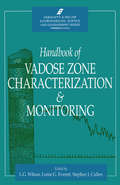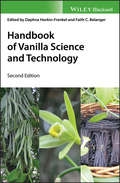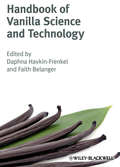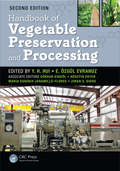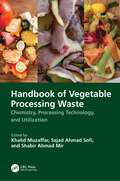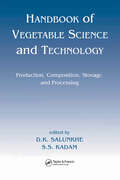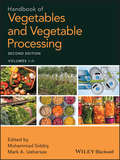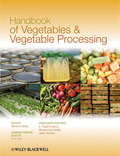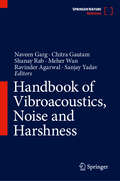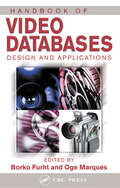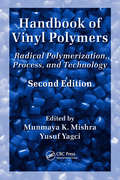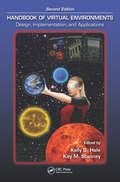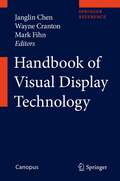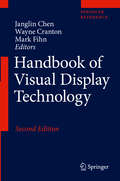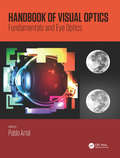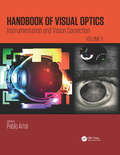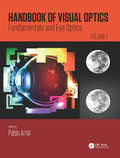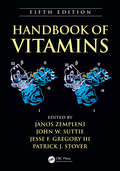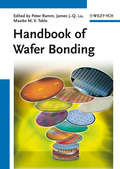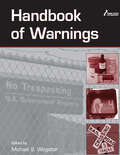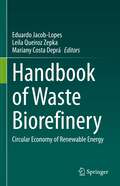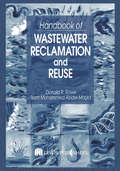- Table View
- List View
Handbook of Vadose Zone Characterization & Monitoring
by Lorne G. Everett L. Gray Wilson Stephen J. CullenThis book is written in a simple, straightforward manner without complicated mathematical derivatives. Compiled by experienced practitioners, this guide covers topics such as basic principles of vadose zone hydrology and prevalent monitoring techniques. Case studies present actual field experiences for the benefit of the reader. The Handbook provides practitioners with the information they need to fully understand the principles, advantages, and limitations of the monitoring techniques that are available.The Handbook of Vadose Zone Characterization & Monitoring expands and consolidates the useful and succint information contained in various ASTM documents, EPA manuals, and other similar texts on the subject, making it an invaluable aid to new practioners and a useful reference for seasoned veterans in the field.
Handbook of Vanilla Science and Technology
by Daphna Havkin-Frenkel Faith C. BelangerAn updated guide to the production, science, and uses of vanilla Vanilla is a flavor and fragrance in foods, cosmetics, pharmaceuticals, and a wealth of other products. Now in its second edition, the Handbook of Vanilla Science and Technology provides a comprehensive and updated review of the science and technology used in these items’ production and supply. Featuring contributions from an international range of experts, this revised edition covers a multitude of topics, including agricultural production, global markets, analytical methods, sensory analysis, food and fragrance applications, organic farming and fair trade, botanical diseases, and novel uses. The Handbook of Vanilla Science and Technology, Second Edition is a vital resource for producers, distributors, and scientists involved in vanilla’s growth and utilization, and offers readers: A guide to the cultivation, extraction, analysis, DNA sequencing, and marketing of vanilla Information on the production of vanilla in a range of countries such as Mexico, Australia, Costa Rica, and India Guidelines on the quality control of vanilla beans and extracts Information on fair trade and the future of vanilla
Handbook of Vanilla Science and Technology
by Daphna Havkin-Frenkel Faith C. BelangerVanilla is the world's most commonly-used flavour and fragrance, used in foods, cosmetics, pharmaceuticals and other products and is therefore of considerable economic importance. This book provides a comprehensive overview of the science and technology used in the production and supply chain of vanilla products. A wide range of international authors cover topics which include agricultural production, global markets, analytical methods, sensory analysis, food and fragrance applications, organic and fair trade vanilla, diseases that affect vanilla, and novel uses. It is of interest to academic researchers in this field and is also an important resource for the vanilla industry and those companies that use vanilla and vanillin as flavours and fragrances worldwide. Key Features: The only book to cover such a wide range of topics on this most commercially valuable of flavour ingredients Includes an analysis of the current vanilla markets in the US and Europe Edited by experts who hold roles in the flavour industry and academic research
Handbook of Vegetable Preservation and Processing (Food Science and Technology)
by Y. H. HUI • E. ÖZGÜL EVRANUZThe second edition of a bestseller, Handbook of Vegetable Preservation and Processing compiles the latest developments and advances in the science and technology of processing and preservation of vegetables and vegetable products. It includes coverage of topics not found in similar books, such as nutritive and bioactive compounds of vegetables; veg
Handbook of Vegetable Processing Waste: Chemistry, Processing Technology, and Utilization
by Shabir Ahmad Mir Khalid Muzaffar Sajad Ahmad SofiHandbook of Vegetable Processing Waste: Chemistry, Processing Technology, and Utilization serves as an essential resource for food scientists, environmental engineers, and industry professionals. This comprehensive book explores innovative and sustainable approaches in managing vegetable processing waste and transforming it into valuable resources. The book addresses chemistry, processing technology, and valorization of residues generated during vegetable processing. It provides an overview of the recovery of bioactive components from the vegetable processing waste and their utilization in the development of functional food.Key features: Provides comprehensive information about the chemistry of waste generated during vegetable processing Provides in-depth information about the bioactive and nutraceutical potential of residues obtained during processing of vegetables Provides insight into technologies which can be used for extraction of biofunctional compounds from vegetable-based processing waste Highlights valorization of vegetable processing waste in fabrication of novel functional foods
Handbook of Vegetable Science and Technology: Production, Compostion, Storage, and Processing
by D. K. Salunkhe S. S. Kadam"Furnishes exhaustive, single-source coverage of the production and postharvest technology of more than 70 major and minor vegetables grown in tropical, subtropical, and temperate regions throughout the world. Provides comparative data for each vegetable presented. "
Handbook of Vegetables and Vegetable Processing
by Muhammad Siddiq Mark A. UebersaxHandbook of Vegetables and Vegetable Processing, Second Edition is the most comprehensive guide on vegetable technology for processors, producers, and users of vegetables in food manufacturing.This complete handbook contains 42 chapters across two volumes, contributed by field experts from across the world. It provides contemporary information that brings together current knowledge and practices in the value-chain of vegetables from production through consumption. The book is unique in the sense that it includes coverage of production and postharvest technologies, innovative processing technologies, packaging, and quality management. Handbook of Vegetables and Vegetable Processing, Second Edition covers recent developments in the areas of vegetable breeding and production, postharvest physiology and storage, packaging and shelf life extension, and traditional and novel processing technologies (high-pressure processing, pulse-electric field, membrane separation, and ohmic heating). It also offers in-depth coverage of processing, packaging, and the nutritional quality of vegetables as well as information on a broader spectrum of vegetable production and processing science and technology. Coverage includes biology and classification, physiology, biochemistry, flavor and sensory properties, microbial safety and HACCP principles, nutrient and bioactive properties In-depth descriptions of key processes including, minimal processing, freezing, pasteurization and aseptic processing, fermentation, drying, packaging, and application of new technologies Entire chapters devoted to important aspects of over 20 major commercial vegetables including avocado, table olives, and textured vegetable proteins This important book will appeal to anyone studying or involved in food technology, food science, food packaging, applied nutrition, biosystems and agricultural engineering, biotechnology, horticulture, food biochemistry, plant biology, and postharvest physiology.
Handbook of Vegetables and Vegetable Processing (Food Science And Technology Ser.)
by E. Özgül Evranuz Jasim Ahmed Muhammad Siddiq Nirmal Sinha Y. H. HuiVegetables are an important article of commerce both in developed and developing economies. Many studies point to importance of vegetables in our diet. Handbook of Vegetables and Vegetable Processing serves as a reference handbook on vegetables and vegetable processing containing the latest developments and advances in this fast growing field. The book can be considered as a companion to Y. H. Hui’s popular Handbook of Fruits and Fruit Processing (2006). Handbook of Vegetables and Vegetable Processing is contemporary in scope, with in-depth coverage of new interdisciplinary developments and practices in the field of vegetables emphasizing processing, preservation, packaging, and nutrition and food safety. Coverage includes chapters on the biology, horticultural biochemistry, microbiology, nutrient and bioactive properties of vegetables and their significant commercialization by the food industry worldwide. Full chapters are devoted to major vegetables describing aspects ranging from chemistry to processing and preservation. World-renowned editors and authors have contributed to this essential handbook on vegetables and their production, technology, storage, processing, packaging, safety and commercial product development. Special Features: Coverage includes biology and classification, physiology, biochemistry, flavor and sensory properties, microbial safety and HACCP principles, nutrient and bioactive properties In-depth descriptions of key processes including, minimal processing, freezing, pasteurization and aseptic processing, fermentation, drying, packaging, and application of new technologies Entire chapters devoted to important aspects of over 20 major commercial vegetables including avocado, table olives and textured vegetable proteins Unparalleled expertise on important topics from more than 50 respected authors
Handbook of Vibroacoustics, Noise and Harshness
by Sanjay Yadav Naveen Garg Meher Wan Shanay Rab Chitra Gautam Ravinder AgarwalThe handbook covers the topics of vibro-acoustics, noise, harshness and their related applications in detail. Various topics covered in this handbook are acoustics and vibration metrology, environmental noise measurements, building acoustics, acoustical meta-materials, underwater acoustics, soundscape approach, beam forming approach, 3D noise mapping, in-situ acoustical testing, etc. The handbook would provide a single window source of up-to-date information to the researchers, acousticians, noise and vibration control engineers, metrologists, industry, university graduates, masters, academicians, administrators, policymakers, regulators, and other stakeholders for a better understanding of vibro-acoustics, noise, harshness and related applications.
Handbook of Video Databases: Design and Applications (Internet and Communications)
by Borko Furht Oge MarquesTechnology has spurred the growth of huge image and video libraries, many growing into the hundreds of terabytes. As a result there is a great demand among organizations for the design of databases that can effectively support the storage, search, retrieval, and transmission of video data. Engineers and researchers in the field demand a comprehensi
Handbook of Vinyl Polymers: Radical Polymerization, Process, and Technology, Second Edition
by Yusuf Yagci Munmaya K. MishraRadical polymerization is one of the most widely used means of producing vinyl polymers, supporting a myriad of commercial uses. Maintaining the quality of the critically acclaimed first edition, the Handbook of Vinyl Polymers: Radical Polymerization, Process, and Technology, Second Edition provides a fully updated, single-volume source on t
Handbook of Virtual Environments: Design, Implementation, and Applications, Second Edition (Human Factors and Ergonomics)
by Kelly S. Hale Kay M. StanneyA Complete Toolbox of Theories and TechniquesThe second edition of a bestseller, Handbook of Virtual Environments: Design, Implementation, and Applications presents systematic and extensive coverage of the primary areas of research and development within VE technology. It brings together a comprehensive set of contributed articles that address the
Handbook of Visual Display Technology
by Janglin Chen Wayne Cranton Mark FihnThis handbook offers a comprehensive description of the science, technology, economic and human interface factors associated with the displays industry. With expert contributions from over 150 international display professionals and academic researchers, it covers all classes of display device and discusses established principles, emergent technologies, and particular areas of application.
Handbook of Visual Display Technology
by Janglin Chen Wayne Cranton Mark FihnThe second Edition of this remarkable Handbook offers readers a comprehensive overview of the science and technology of visual displays and the economic and human interface factors associated with the displays industry. Unique in the displays field, the Handbook serves as a single reference source with expert contributions from over 150 international display professionals and academic researchers. The Handbook contains extensive coverage of established and emerging display technologies, with discussion of physical principles, materials science and processing, device technologies and particular areas of application. The wide-ranging content also encompasses the fundamental science of light and vision, image acquisition and manipulation, display materials and processing techniques, TFTs, display driving and metrology. Prominence is given to liquid crystal displays, with later chapters devoted to emerging technologies including flexible displays, electrophoretic, electrowetting and electrofluidic displays and MEMS-based displays. Other sections consider 3D display solutions, projection systems and head-worn displays. Updated and extended throughout, major changes in the 2nd Edition include: * Significantly expanded section on touch and human-computer interaction * Reworked and updated chapters on OLEDs * Revised and extended coverage of mobile display technologies ". . . no engineering or science library can be without this book. It will be an asset for all companies engaged in display and display-related business. " - extract from the Foreword of the 1st Edition by Dr M Anandan, President, Society for Information Display.
Handbook of Visual Optics, Two-Volume Set
by Pablo ArtalHandbook of Visual Optics offers an authoritative overview of encyclopedic knowledge in the field of physiological optics. It builds from fundamental concepts to the science and technology of instruments and practical procedures of vision correction, integrating expert knowledge from physics, medicine, biology, psychology, and engineering. The chapters comprehensively cover all aspects of modern study and practice, from optical principles and optics of the eye and retina to novel ophthalmic tools for imaging and visual testing, devices and techniques for visual correction, and the relationship between ocular optics and visual perception.
Handbook of Visual Optics, Volume Two: Instrumentation and Vision Correction
by Pablo ArtalHandbook of Visual Optics offers an authoritative overview of encyclopedic knowledge in the field of physiological optics. It builds from fundamental concepts to the science and technology of instruments and practical procedures of vision correction, integrating expert knowledge from physics, medicine, biology, psychology, and engineering. The chapters comprehensively cover all aspects of modern study and practice, from optical principles and optics of the eye and retina to novel ophthalmic tools for imaging and visual testing, devices and techniques for visual correction, and the relationship between ocular optics and visual perception.
Handbook of Visual Optics: Fundamentals and Eye Optics, Volume One
by Pablo ArtalHandbook of Visual Optics offers an authoritative overview of encyclopedic knowledge in the field of physiological optics. It builds from fundamental concepts to the science and technology of instruments and practical procedures of vision correction, integrating expert knowledge from physics, medicine, biology, psychology, and engineering. The chapters comprehensively cover all aspects of modern study and practice, from optical principles and optics of the eye and retina to novel ophthalmic tools for imaging and visual testing, devices and techniques for visual correction, and the relationship between ocular optics and visual perception.
Handbook of Vitamins
by Patrick J. Stover Janos Zempleni John W. Suttie Jesse F. Gregory IIIWithin the last few years, knowledge about vitamins has increased dramatically, resulting in improved understanding of human requirements for many vitamins. This new edition of a bestseller presents comprehensive summaries that analyze the chemical, physiological, and nutritional relationships, as well as highlight newly identified functions, for a
Handbook of Wafer Bonding
by Maaike M. Taklo James Jian-Qiang Lu Peter RammThe focus behind this book on wafer bonding is the fast paced changes in the research and development in three-dimensional (3D) integration, temporary bonding and micro-electro-mechanical systems (MEMS) with new functional layers. Written by authors and edited by a team from microsystems companies and industry-near research organizations, this handbook and reference presents dependable, first-hand information on bonding technologies. Part I sorts the wafer bonding technologies into four categories: Adhesive and Anodic Bonding; Direct Wafer Bonding; Metal Bonding; and Hybrid Metal/Dielectric Bonding. Part II summarizes the key wafer bonding applications developed recently, that is, 3D integration, MEMS, and temporary bonding, to give readers a taste of the significant applications of wafer bonding technologies.This book is aimed at materials scientists, semiconductor physicists, the semiconductor industry, IT engineers, electrical engineers, and libraries.
Handbook of Warnings (Human Factors and Ergonomics)
by Michael S. WogalterA technical discussion that includes theory, research, and application, this book describes warning design standards and guidelines; aspects of law relevant to warnings such as government regulations, case/trial litigation, and the role of expert testimony in these cases; and international, health/medical, and marketing issues. Broken into thirteen
Handbook of Waste Biorefinery: Circular Economy of Renewable Energy
by Eduardo Jacob-Lopes Leila Queiroz Zepka Mariany Costa DepráThis handbook discusses the latest developments in biorefinery technologies for waste-to-energy conversion. The growing global population and the accompanying increase in consumption and waste production make it urgent to find the best possible use of our resources. A sustainable waste management under the biorefinery concept has great potential to support a sustainable circular economy and green energy production.This handbook is divided into four parts. First, the reader is introduced to the fundamentals and recent trends of waste-to-energy technologies. The second part describes in detail the current status, challenges, and potential of the different feedstocks used for waste-to-energy conversion. Here, municipal solid waste, sewage sludge, oils and greases generated during food preparation, industrial wastewaters, and agricultural wastes, to name a few, are introduced. In the third part, numerous waste-to-energy technologies are discussed in detail, including anaerobic digestion, composting, gasification, plasma technology, thermal cracking, and others. Advantages and optimization potentials of these technologies for efficient residue management, quality and yield are highlighted.Finally, the handbook discusses social, environmental and economic aspects of waste-to-energy biorefinery technologies. Readers will learn more about the major bottlenecks and solutions in bioenergy commercialization, the logistics of biomass supply and the carbon footprint of waste biorefineries. The ideas and technologies presented in this book contribute to the UN Sustainable Development Goal (SDG) of "Affordable and Clean Energy".This book is a useful reference for postgraduate students and researchers interested in biorefinery and biofuel technologies, both in academia- and commercial laboratories. Early career scientists can use it to fast track into the field. Advanced scientists will find it helpful in gaining a broader overview of the field beyond their area of specialization.
Handbook of Wastewater Reclamation and Reuse
by Donald R. Rowe Isam Mohammed Abdel-MagidThis comprehensive reference provides thorough coverage of water and wastewater reclamation and reuse. It begins with an introductory chapter covering the fundamentals, basic principles, and concepts. Next, drinking water and treated wastewater criteria, guidelines, and standards for the United States, Europe and the World Health Organization (WHO) are presented. Chapter 3 provides the physical, chemical, biological, and bacteriological characteristics, as well as the radioactive and rheological properties, of water and wastewater. The next chapter discusses the health aspects and removal treatment processes of microbial, chemical, and radiological constituents found in reclaimed wastewater. Chapter 5 discusses the various wastewater treatment processes and sludge treatment and disposal. Risk assessment is covered in chapter 6. The next three chapters cover the economics, monitoring (sampling and analysis), and legal aspects of wastewater reclamation and reuse.This practical handbook also presents real-world case studies, as well as sources of information for research, potential sources for research funds, and information on current research projects. Each chapter includes an introduction, end-of-chapter problems, and references, making this comprehensive text/reference useful to both students and professionals.
Handbook of Water Analysis
by Leo M. L. Nollet Leen S. P. De GelderExtensively revised and updated, Handbook of Water Analysis, Third Edition provides current analytical techniques for detecting various compounds in water samples. Maintaining the detailed and accessible style of the previous editions, this third edition demonstrates water sampling and preservation methods by enumerating different ways to measure c
Handbook of Water Harvesting and Conservation: Basic Concepts and Fundamentals (New York Academy of Sciences)
by Saeid Eslamian Faezeh EslamianWater harvesting is gaining more and more recognition as a sustainable and resilient water supply options. It is economically viable, socially compatible and environmentally friendly. Water harvesting has proven to be a robust solution to overcome or reduce water shortages all over the world. It is important to understand how to apply this practice in a sustainable and effective way to make full use of its potential in a world increasingly threatened by water scarcity. The Handbook of Water Harvesting and Conservation: Basic Concepts and Fundamentals is the most comprehensive, up-to-date and applied handbook on water harvesting and conservation yet published. The book’s 30 chapters -- written by 84 outstanding international experts from approximately 20 selected countries faced by drought -- explore, critique and develop concepts and systems for water harvesting. The editors bring together many perspectives into a synthesis that is both academically based and practical in its potential applications. The Handbook of Water Harvesting and Conservation: Basic Concepts and Fundamentals is an important tool for education, research and technical works in the areas of soil, water and watershed management and is highly useful for drought strategy planning, flood management and developing techniques to adapt to climate change in urban, agricultural, forest and rangeland areas.
Handbook of Water Harvesting and Conservation: Case Studies and Application Examples (New York Academy of Sciences)
by Saeid EslamianWater harvesting is gaining more and more recognition as the sustainable and resilient alternative to other water supply options. It is economically viable, socially compatible and environmentally friendly. Water harvesting has proven to be a robust solution to overcome or reduce water shortages all over the world. To apply this in a sustainable and effective way, it is important to understand exactly where it can be applied to make full use of its potential. The Handbook of Water Harvesting and Conservation: Case Studies and Application Examples is the most comprehensive, up-to-date and applied casebook on water harvesting and conservation yet published. The editors bring together the many perspectives into a synthesis that is both academically-based and practical in its potential applications. The Handbook of Water Harvesting and Conservation: Case Studies and Application Examples will be an important tool for education, research and technical works in the soil, water and watershed management area, and will be highly useful for drought strategy planning, flood management and adaptation to climate change in all urban, agricultural, forest, rangeland areas.
